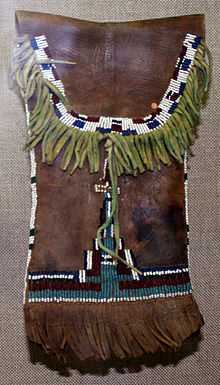Faturan
Faturan in Middle Eastern beadwork refers to a variety of materials such as Bakelite used to make beads, notably in the making of komboloi and misbaha.
History
Originally, Faturan was a brand of cast thermosetting phenol formaldehyde resin, similar to Bakelite, manufactured by Dr. H Traun u. Sohne of Hamburg.[1][2] Faturan was the invention of Dr Friedrich Adolf Traun, Dr Heinrich Traun's son, hence the name FATuran. On him, who together with his Irish partner John Pius Boland became lawn tennis doubles champion at the Athens Olympic Games of 1896, see Heiner Gillmeister, Olympisches Tennis, St Augustin 1993, pp. 13-21. Developed in the early 20th century, faturan became obsolete by the 1940s.
In the bead trade
In the bead trade, faturan is often thought to be a mixture of natural amber shavings with other materials, and is described as having been invented in the Middle East in the 18th or 19th century.
The first Bakelite arrived mainly to Turkey was in the form of drawer and furniture knobs and handles around 1909/1911. This is the time when the first prayer bead strands made of what we now call faturan started to appear on the market.
The bead carvers, mainly in Turkey, were swift to understand that Bakelite was a material that could be well carved, had a great appearance and could replace amber. Each master also had his secret "recipe,", even heating in various liquids and oils and making it undergo various physical or chemical processes to obtain the most beautiful aspect.
The original and genuine Faturan beads were mainly red or yellow in all its shades. The last genuine faturan beads were made in 1940 mainly due to the Second World War when the supply of raw material became very scarce. Normally, the last genuine faturan beads date of the late 1940s when the supply of the raw material that was sill left from the prewar stocks was terminated. After the Second World War the production stopped mainly due to the general severe restrictions that prevailed all over the world.
The demand for genuine faturan – often confused for amber - has always been great among prayer bead, tesbih and komboloi collectors. It has increased in the last ten years so much that it has attracted a great amount of "fake" faturan on the market. By "fake," collectors mean newly manufactured phenolic resin either purposefully or ignorantly presented as genuine faturan.
The result of this low-quality impostor material is that, today, there exists a very big confusion in the use of the word Faturan as well as about its meaning to the extent that practically any kind of phenolic resin is called unjustly Faturan, even those which are produced nowadays.
Genuine pre-1940 faturan - beads still intact, and in complete strands, made from one single type of material - are considered museum items and fetch extremely high prices by both institutional and individual auction bidders.
Notes
- ↑ Baekeland, L. H.; Bender, H. L. (1925). "Phenol Resins and Resinoids". Industrial and Engineering Chemistry 17 (3): 225–237. doi:10.1021/ie50183a002.
- ↑ "Trade Names E–H". Plastics Historical Society.
| ||||||||||||||||||||
